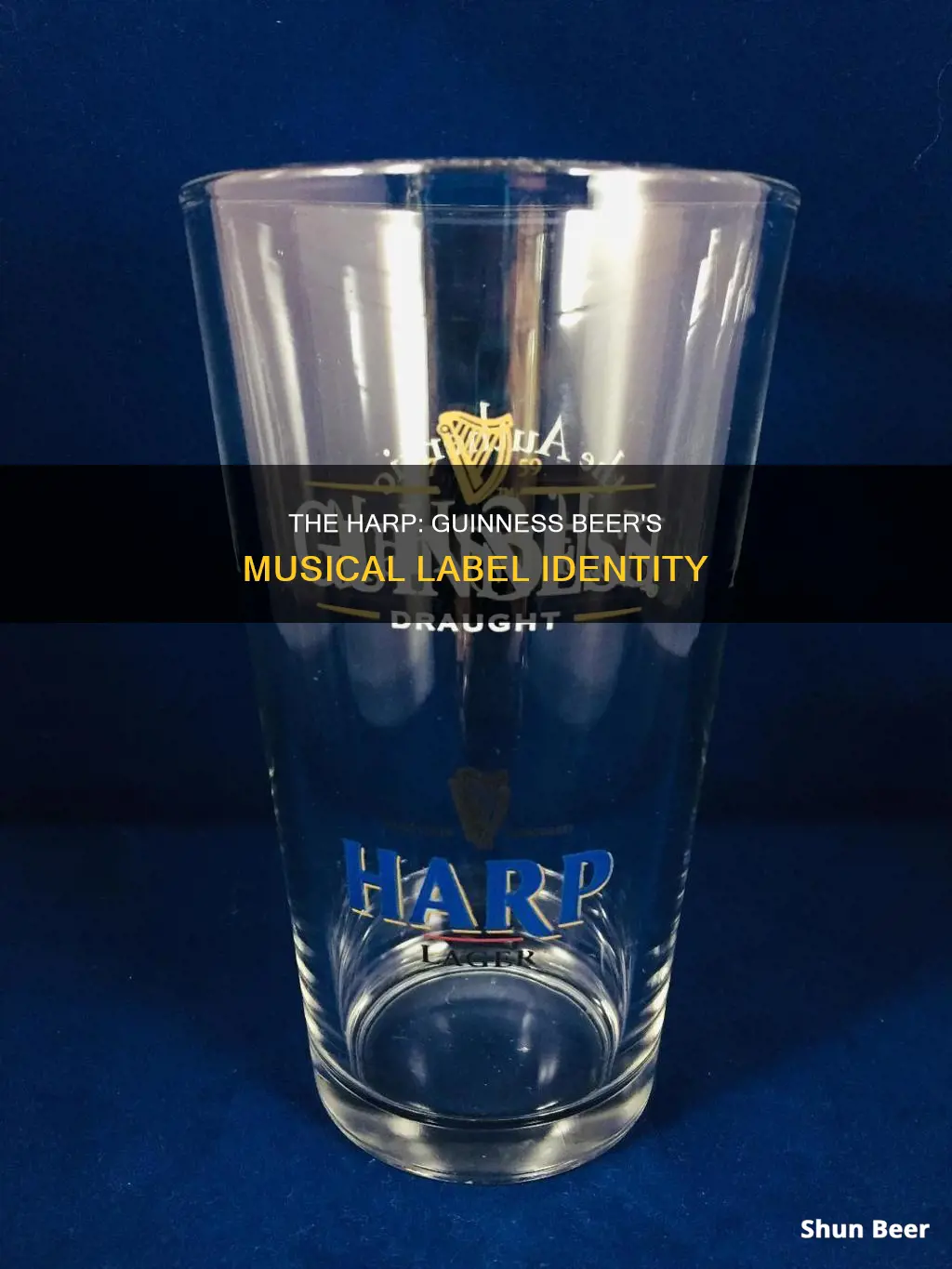
The harp is the musical instrument that appears on the Guinness beer label. The harp, also known as the Downhill Harp or the Brian Boru Harp, has been a symbol of Ireland and has been linked with Guinness since 1862, when it was used as an emblem on its first bottle. The harp was later registered as a Guinness corporate trademark in 1876, and in 1960, Guinness named its first lager Harp. The Guinness logo has been redesigned several times but remains very similar to the original version.
| Characteristics | Values |
|---|---|
| Instrument | Harp |
| Harp Type | Wire-strung Irish harp, also known as a cláirseach |
| Harp Name | O'Neill, Brian Boru, or Downhill Harp |
| Harp Strings | 11 (originally 20) |
| Harp Location | Library of Trinity College, Dublin |
| Harp Use | Guinness emblem/logo since 1862 |
| Harp Trademark | Registered in 1876 |
| Harp-Related Beer | Guinness's first lager was named "Harp" in 1960 |
What You'll Learn

The harp is the Guinness emblem
The harp is also the official national emblem of the Republic of Ireland and can be found on the Republic's coinage. However, there is a difference between the Irish government harp and the Guinness harp. As Guinness had trademarked the harp symbol in 1876, the Irish Free State Government of 1922 had to turn the official government harp the other way around to differentiate between the two. The distinguishing feature between the two harps is that the Guinness Harp always appears with its straight edge (the soundboard) to the left, and the government harp is always shown with its straight edge to the right.
The harp is one of three elements that make up the Guinness livery. The other two elements are the Guinness word and Arthur Guinness's famous signature. There have been a number of changes to the design of the harp device over the years, including a reduction in the number of strings shown. The current harp was introduced in 2005 when a new brand livery was launched.
In 1960, Guinness even named its first lager "Harp" because of the harp trademark.
Guinness Beer: Wheat-Free, But What's the Secret?
You may want to see also

The harp is the national emblem of the Republic of Ireland
The harp has been a symbol of Ireland since the 16th century. It is present in the Irish presidential seal, official documents, passports, Irish euro coins, and more. It is also featured on the coat of arms of Ireland, blazoned as Azure a harp Or, stringed Argent (a gold harp with silver strings on a blue background). These arms have long been Ireland's heraldic emblem, with references to them as being the arms of the king of Ireland dating back to the 13th century.
The harp's presence in Ireland dates back over a thousand years. It can be seen on manuscripts and Christian stone crosses, which date back to the 8th century. In old Gaelic society, Chieftains would be accompanied by a bard and a harper. Harpers were highly valued and studied for decades, often at the centre of Gaelic social life.
The harp that the Guinness logo is based on is known as the "O'Neill" or "Brian Boru" harp. It is a famous 14th-century Irish harp that is now preserved in the Library of Trinity College Dublin. The "Brian Boru" harp is believed to have been played by Brian Boru, the last high King of Ireland. Guinness's harp logo has been redesigned several times, although it remains very similar to the original version.
Guinness Beer's pH Mystery: Acidic or Not?
You may want to see also

The harp on the Guinness label is based on the O'Neill or Brian Boru harp
The harp came into Boru's possession in the 11th century and was gifted by his son to the Pope in 1064. The harp then travelled around Europe and England for over 700 years before finally settling at Trinity College in 1782, where it has remained ever since. The harp's alternate name, the "O'Neill Harp", refers to Arthur O'Neill, an 18th-century blind harpist who is said to have tuned and played the harp in a parade in Limerick.
The harp has been used as a symbol of Ireland and its rich artistic traditions, appearing on the Presidential seal, Irish passports, and the coat-of-arms of the National University of Ireland. It is also the official national emblem of the Republic of Ireland and can be found on the country's coins and currency. Given its significance in Irish culture and history, it is no surprise that Guinness chose to adopt the harp as its trademark symbol.
In 1862, Arthur Guinness decided to use an image of the Boru/O'Neill harp on his trademark label, along with the Guinness name and his signature. The symbol was legally registered as a Guinness trademark in 1876. The harp has undergone several alterations over the years, with the current version introduced in 2005, featuring a simplified design with fewer strings.
Breast Milk and Guinness Beer: Any Connection?
You may want to see also

Guinness named its first lager Harp
The harp, which appears on the Guinness label, is based on a famous 14th-century Irish harp known as the "O'Neill" or "Brian Boru" harp. This harp is now preserved in the Library of Trinity College Dublin. Harps have been a symbol of Ireland since the 16th century and have been linked with Guinness since 1862, when it was used as an emblem on its first bottle. The harp was later registered as a Guinness corporate trademark in 1876.
In 1960, Guinness named its first lager "Harp". Harp Lager is an Irish lager created in response to the trend among drinkers in Ireland and Britain towards Continental lager. Various names were considered for the brand, including Atlas, Cresta and Dolphin, before Harp was chosen. The brand was marketed with the Brian Boru harp as its emblem. The harp is one of three elements that make up the Guinness livery, the other two being the Guinness word and Arthur Guinness's famous signature.
The harp is also the official national emblem of the Republic of Ireland and can be found on the Republic's coinage. However, there is a difference between the Irish government harp and the Guinness harp. As Guinness trademarked the harp symbol in 1876, the Irish Free State Government of 1922 had to turn the official government harp the other way around to differentiate it from the Guinness harp. The distinguishing feature between the two harps is that the Guinness Harp always appears with its straight edge (the soundboard) to the left, while the government harp is always shown with its straight edge to the right.
Guinness Beer: The Mystery of the Plastic Ball
You may want to see also

Guinness redesigned the harp logo several times
The instrument that appears on the label of Guinness beer is a harp. To be precise, it's the "Brian Boru" or "O'Neill" harp, a famous 14th-century Irish harp now preserved in the Library of Trinity College Dublin. The harp has been a symbol of Ireland since the 16th century and has been synonymous with Guinness since 1862, when it was used as an emblem on its first bottle. The harp was registered as a Guinness trademark in 1876, and the company even named its first lager "Harp" in 1960.
The harp is one of three elements that make up the Guinness livery, along with the word "Guinness" and Arthur Guinness's signature. Over the years, the harp device has undergone several redesigns, with changes to its orientation, shape, and string count. The current harp logo, introduced in 2005, features a simplified image with fewer lines and only 11 strings, compared to 20 strings on the original 1862 design.
The first major redesign of the Guinness harp occurred in 1955, almost a century after its creation. This update removed the word "trademark" and introduced other details, while also reversing the colours, with white accents on a black background. In 1968, the company adopted a simplified version of the logo, removing many of the intricate details on the instrument and reducing the number of strings to nine.
A new version of the logo was introduced in 1995, bringing back some of the previously removed details but in a simplified form. However, this design was short-lived, as Guinness redesigned its image again just a few years later in 1999, opting for an even more streamlined version of the logo without any intricate details. The most recent update to the harp logo took place in 2005, resulting in a more refined and modern interpretation of the original design. Despite the various redesigns, the harp logo has retained its fundamental structure and distinctive character over the years.
Guinness: A Dark Porter Beer With a Rich History
You may want to see also
Frequently asked questions
A harp, specifically, the Downhill Harp or the Brian Boru Harp.
The harp is a symbol of Ireland and has been since the 16th century.
The harp was first used as a symbol on the first bottle label of Guinness in 1862.
Guinness chose the harp as it is a famous 14th-century Irish harp known as the "O'Neill" or "Brian Boru" harp, now preserved in the Library of Trinity College, Dublin.







